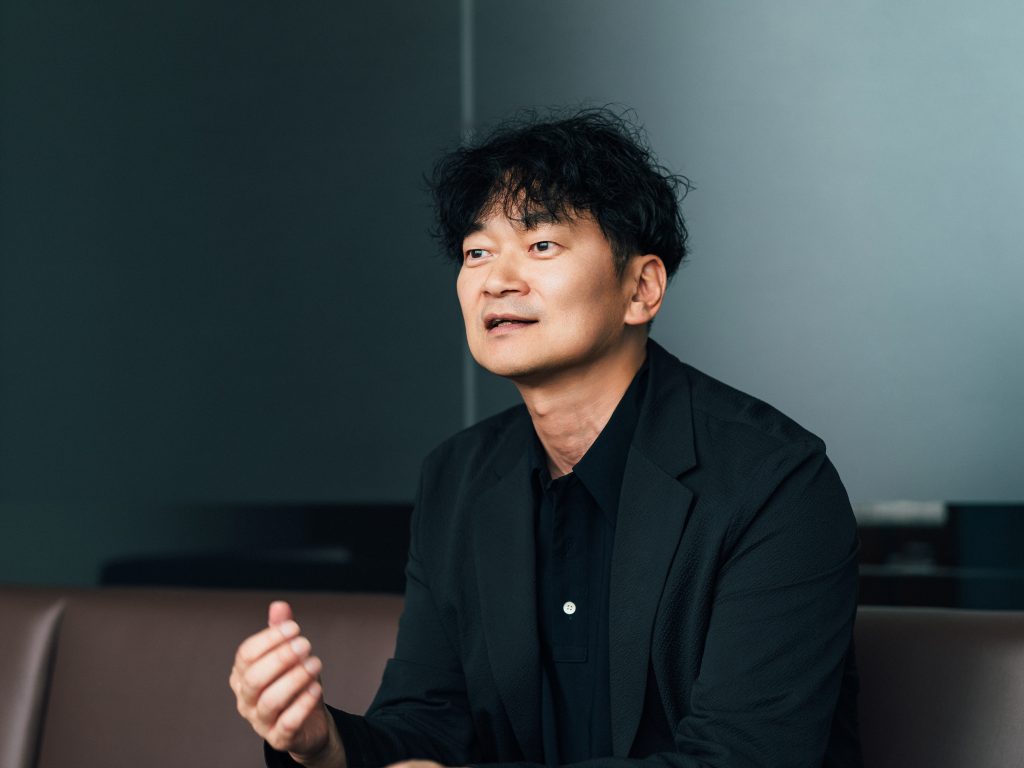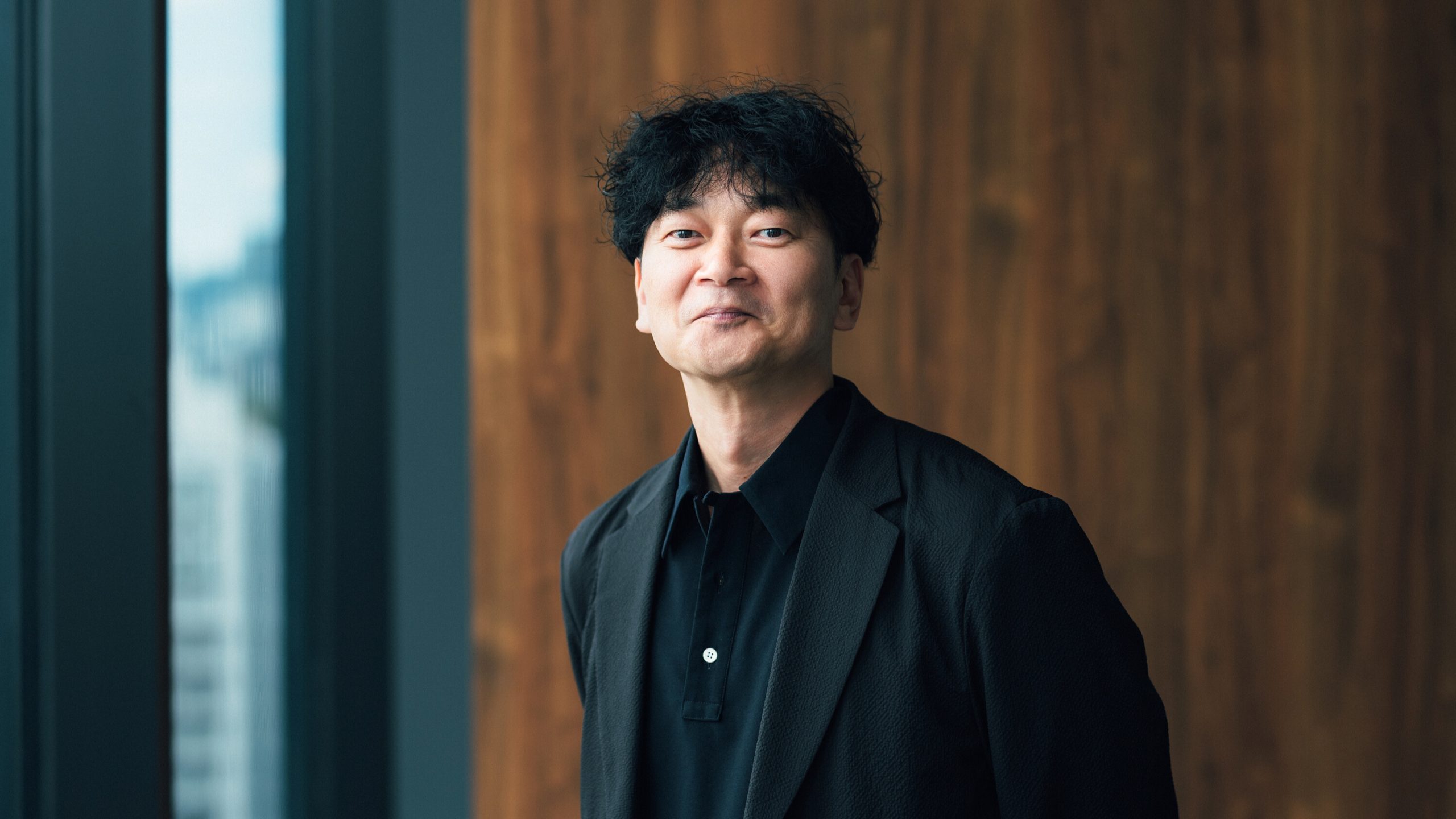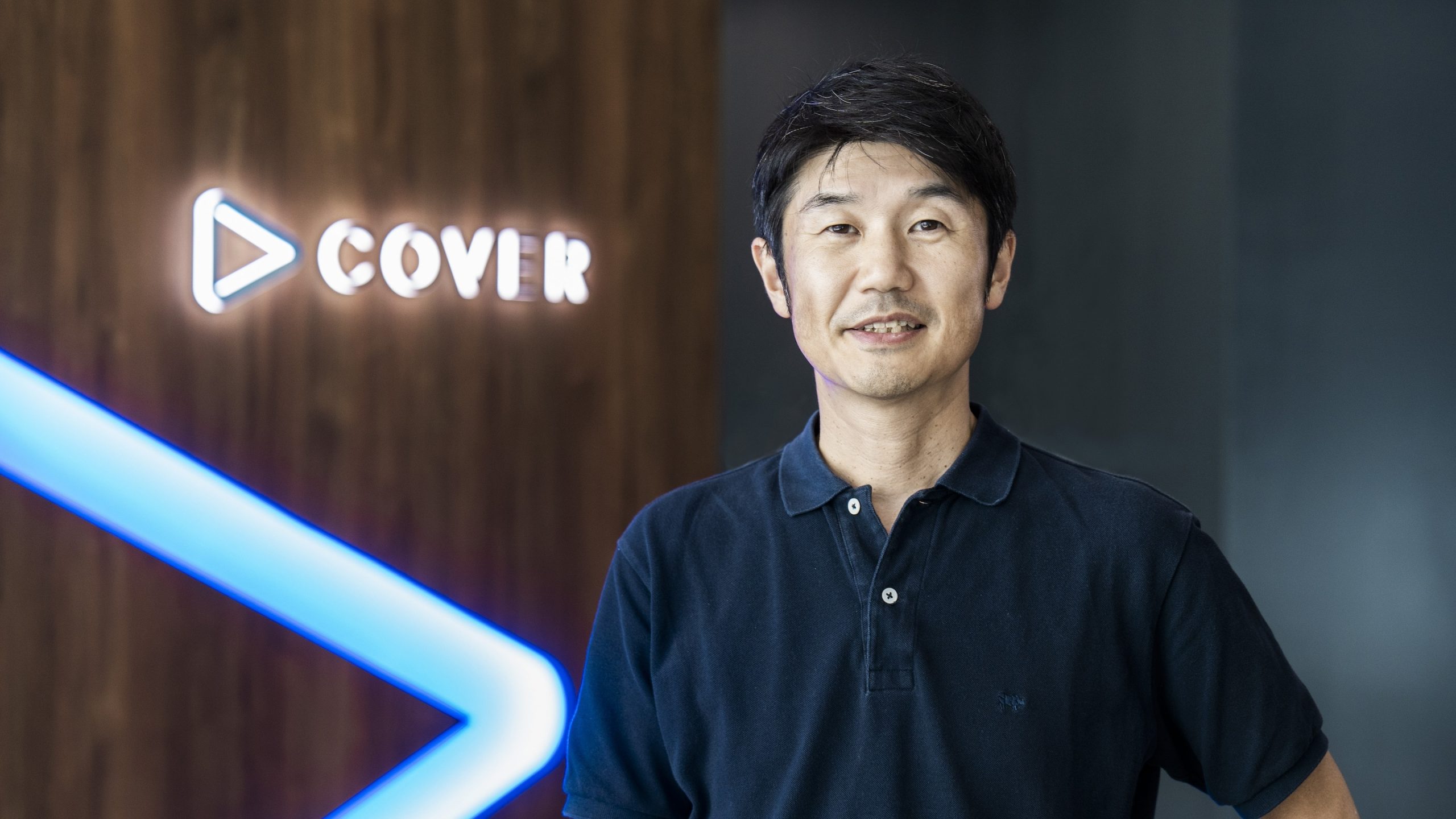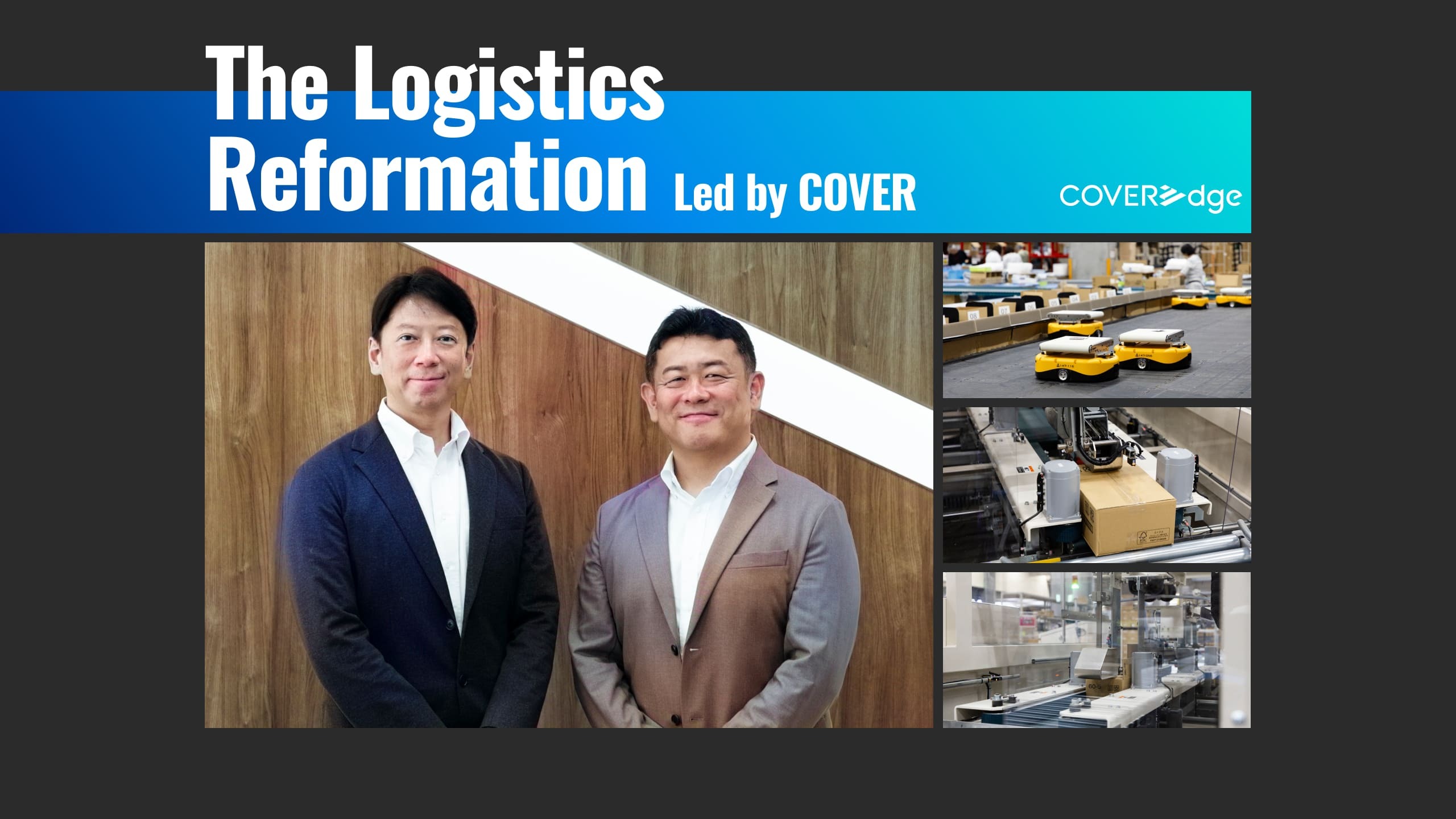
Appointed as an outside director of COVER in 2023 and stepping in as a full-time director in April 2025, Shuhei Ueda now leads the company’s media-mix domain.
We sat down with Shuhei Ueda to discuss the reasons behind this decision as one of the final challenges of his career, the future of the VTuber market as Japan’s content exports enter the 20 trillion yen era, the company’s global expansion stage, and the fundamental issues facing the industry.
Director Shuhei Ueda
Shuhei Ueda joined Imaginner Co., Ltd. as a new graduate. Founded Gamepot Inc. in 2001. Shuhei Ueda was a pioneer of FreeToPlay and led the dawn of online games. The Company went public in 2005. Then he served as representative director of Japanese subsidiary of AfreecaTV Co., Ltd., a major live streaming service in South Korea, as well as several other companies. He is co-chairman of Japan Online Game Association.
Taking on a Final Challenge: Joining Full-Time with Confidence in a 20 Trillion Yen Content Market
―You became an outside director of COVER in 2023 and assumed a full-time director role in April 2025. What was behind your decision to join the company full-time and take on this new challenge?
I originally knew Tanigo CEO from our time together at Imagineer, where we had a senior-junior relationship. We had stayed in touch over the years, exchanging advice at key points and I even visited the office during the early days of COVER to hear updates about the business. Then, in 2023, I officially joined the company as an outside director. At that time, there had already been discussions about me taking on a full-time director role. However, what ultimately convinced me to make that commitment was my firm belief that the VTuber market holds the potential to grow on a truly global scale.
I was torn between staying in a governance role as an outside director or stepping up as a full-time executive to take charge of business development and oversee our global expansion myself. Considering my age, I realized this would probably be my last chance to devote myself completely to a company, and to have the opportunity to fully leverage my experience and connections and help build a company that can truly compete on the global stage filled me with genuine excitement. That’s what ultimately led me to take on the role full-time.
―What aspects led you to believe that the VTuber market has the potential to grow globally?
Japan’s content exports have shown steady growth in recent years, reaching nearly 5 trillion yen in 2023 – exceeding the export value of the semiconductor and railway industries, and coming close to the size of the automobile industry. According to projections, this figure is expected to rise to around 20 trillion by 2033*1.
The rise of OTT services*2 like Netflix has had an enormous influence in recent years. By 2025, Japanese content is projected to capture nearly 29% of the North American market*3, reflecting how anime and anime-style VTuber have become increasingly recognized and embraced worldwide.
As people become more familiar with and their love for anime-style VTubers continues to grow, it’s easy to envision a future where they become the central hub that brings together gaming, anime, and music across the globe. By reaching these fanbases around the world, VTubers have the potential to evolve into a truly global form of entertainment.
*1: Source: Ministry of Economy, Tarde and Industy (METI), “エンタメ・クリエイティブ産業戦略 ~コンテンツ産業の海外売上高20兆円に向けた 5ヵ年アクションプラン~” (Entetainment and Creative Industry Strategy – Five-Year Action Plan Toward 20 Trillion Yen in Overseas Content Sales)(Japanese Only)
*2: OTT (Over-the-Top) services: Refers to content and media services, such as messaging, audio, and video, delivered directly to users over the internet
*3: Source: Data and analytics firm Research firm Ampere Analysis, “Japan’s franchises take the lead on Netflix in North America as UK content declines”

A Record-Breaking Achievement at the Taipei Dome – Witnessing the Unstoppable Energy from Fans Worldwide
―You’re in charge of a wide range of fields – media-mix domain. Which of these areas are you focusing on the most right now?
The area we’re putting the most time into right now is global expansion, especially in East Asia and North America. The enthusiasm of our East Asian fans is incredible. Recently, we collaborated with the Taiwanese baseball team Wei Chuan Dragons, hosting a special collaboration game at the Taipei Dome, the largest stadium in Taiwan, and over the course of three days, the event drew record-breaking attendances and merchandise sales, achieving the highest figures ever in the venue’s history. Of course, many people came primarily to watch the baseball game itself, but we also believe that the collaboration with hololive also helped bring a new fanbase into the stadium.
One of the attendees was actually the CEO of a major local company, who came simply because his child is a fan of hololive: hearing that there’s such passion outside of Japan as well makes me want to push our global expansion even further and keep growing our fan community worldwide.
―Having been at the forefront of the entertainment industry since the dawn of online gaming, how do you view the VTuber market as it stands today?
When I joined the gaming industry in around 1996, the voice acting scene hadn’t really become that big yet: it was in the late 1990s when voice actors began to take on idol-like popularity, and events like Comiket started gaining mainstream attention. Around that time, more anime-based games were being released, and voice actors started playing an increasingly important role within those games. The question of how to bring out a character’s personality became a key focus in game development.
I see VTubers as an evolution of that very trend. While the direction we’ve taken is certainly new, and I did sense that this was where things were heading, I’ve still been genuinely surprised by how rapidly the VTuber market has grown.
―Are there any cases or strategies that you look to for inspiration as you advance your global expansion?
In terms of global expansion, I believe hololive production is in a very fortunate position that we already have global fans all over the world. The key challenge now is figuring out how to further expand those markets and reach new audiences who have yet to discover us. That’s exactly what we’re focusing on right now.
One of the most important aspects, in my view, is how we use social media to communicate and how we encourage user-generated content (UGC)*4. At hololive production, fan-created derivative works play a significant role in increasing the popularity of hololive content with many talented external creators producing a wide range of secondary creations, such as clipped videos of stream highlights. These works often serve as the very first point of contact for new fans discovering hololive production.
I also think it’s important to look at examples where companies have considered multilingual support from the outset, creating talent lineups with global audiences in mind. While learning from successful cases around the world, we aim to develop a global expansion strategy that stays true to COVER’s uniqueness.
*4: User-generated Content (UGC): Content created and shared by general users rather than official producers, for example, video clips or fan-made games.

―From your perspective, what do you see as COVER’s greatest strength?
I believe that our greatest strength lies in the incredible passion of our fans. At hololive production, streaming is at the core of what we do. Those streams ignite enthusiasm among our viewers, which then carries over to music concerts, creating a powerful cycle of energy and connection. At those live events, fans come together again and celebrate a common passion, and that passion continues to spread, building a strong sense of unity throughout the community. The thought of how we can carry that passion forward and make it resonate with fans around the world is incredibly exciting.
The atmosphere at trading card game tournaments is a little more subdued than that of live concerts, yet it’s common to see players meeting for the first time start their conversations with a question like, “Who’s your oshi?”, leading to spontaneous interactions among fans. The more touchpoints fans have with each other in different settings, the more the community grows, and that’s where we see exciting chemistry starts to build.
It’s precisely because of such incredible passion from our fans that we’re able to explore many different business opportunities to attempt to meet their expectations. We took on a new challenge in the trading card game space last year, and starting next fiscal year, we’ll be launching a full-scale game business as well. By responding to our fans’ desire for new kinds of experiences, and by offering opportunities that differ from what we’ve done before, we’re able to create entirely new ways for them to enjoy and engage with our content.
I’ve been in the entertainment industry for a long time, but I’ve never seen this level of passion anywhere else. Meeting fans in person and feeling their energy firsthand is incredibly inspiring for me. That’s why I make a point to attend every live concert I can, and I also try to visit trading card game tournaments and shop events whenever possible.
―When you visited these places in person, was there any moment or experience that especially stood out to you?
This summer, we held a gaming event called “hololive GAMERS fes. Cho-Cho-Cho-Cho GAMERS 2” at Saitama Super Arena and right after that, I had a business trip to Osaka and stopped by our official shop, “hololive production official shop in Osaka Umeda, ” in Umeda as well.
I asked the store manager how sales had been recently, and he told me that on the very day of the event in Saitama, merchandise featuring the talents who performed at the event suddenly sold out at the Osaka official shop. Since Osaka and Saitama are rather far apart, I didn’t expect there to be much of a direct correlation: it really surprised me to see that even fans who couldn’t attend the event in person were showing their support by purchasing merchandise.
From these sorts of experiences, I have realized that there’s still a lot more we can do to create deeper backstories and connections between our events and merchandise.
Taking the VTuber Market to the Next Level – Embracing Evolution and New Challenges
―Having been involved in management in the entertainment industry for many years, what do you consider to be most important when it comes to creating entertainment?
When it comes to creating entertainment, the most important thing is to move people emotionally. No matter how deep you dive into data analysis, it alone won’t lead to something truly new or emotionally moving. At my previous company, I often told my team, “Focus on how to appeal to the five senses – how to create something that remains in people’s hearts,” and after putting those ideas into practice, what matters most is whether the end result feels genuinely exciting.
It’s also important to make sure that each individual project doesn’t culminate in a single point, but instead connects with others to form a living story. It’s also crucial that our ideas don’t become predictable – they need to exceed fans’ expectations through creative plans and measures that genuinely surprise and delight them. To achieve that, we have to study what truly makes fans happy, which means having a wide range of ideas to draw from and a deep understanding of our fanbase.
It’s difficult to quantitatively evaluate whether we’re achieving all of these things as a company, but by fostering a culture where people naturally associate the company as being one that truly values these principles, I believe we can nurture more creators who align with our values. Even from a management perspective, I place great importance on creating an environment where such people can thrive.

―The VTuber market has been growing rapidly, but what do you see as the key challenges facing the industry as a whole?
I believe the first wave of the VTuber market has now settled down a bit. When VTuber culture first emerged, the industry was in a state of complete chaos – we were all just figuring things out as we went along. From learning how to interact with fan communities to figuring out how to obtain permissions for game streaming, everyone did what they could at the time and kept moving forward.
However, as the market has gradually matured, we’ve reached a stage now where we need to start thinking about smarter and more strategic ways to move forward. I feel that we’re now right in the middle of that transition period. That said, based on my past experiences, when it comes to moving people through entertainment, becoming too “grown-up” isn’t always a good thing either.
Another major challenge, I think, is creating new career paths for our talents who are pursuing a career in this new profession as VTubers – paths that look ahead 10 or even 20 years into the future. It’s our role to support them so they can continue being a VTuber for many years to come, and as a company, we place great importance on working out how we can create new stages and career opportunities for them along the way. For example, – just to make it easier to visualize – there could be entirely new kinds of units, bases of activity, or even opportunities for talents to take part as producers themselves. I believe it’s important for us, as an industry, to work together to establish these kinds of role models for the future.
―In addition to the challenges facing the industry as a whole, what do you see as the specific challenges for hololive production?
What I’ve been feeling more strongly in recent years is how people’s use of their time in their everyday lives has changed. For example, even in areas like music or Netflix dramas, longer content tends to get skipped, while short, instantly consumable content keeps gaining traction. Because of that, we’re no longer just competing with other VTubers – we’re competing with idols, musicians, artists, anime, and films across every medium of entertainment for people’s time.
For hololive production, live streaming plays a huge role – it’s often through a live stream that viewers truly get to know a talent’s personality and become real fans, which is why I always hope more people will take the time to watch those streams. At the same time, however, I can’t help but feel that in the future, younger generations may find it increasingly difficult to spend long periods of time watching livestreams.
As younger generations grow up with a culture of watching Netflix at 1.5x speed, listening only to the chorus of songs, and rapidly consuming short videos on TikTok, it’s becoming increasingly important to think about how we can make them more interested in hololive production content and encourage them to watch our live streams.
In fact, hololive’s short-form videos have been performing extremely well, which has certainly made it easier to reach a wider audience, but the real challenge now is how to turn those viewers into devoted fans.

Toward Becoming an Essential Force in the Content Industry – COVER’s Five- to Ten-Year Vision
―How do you envision expanding COVER and hololive production in years to come? Could you share what kind of vision you have for the next five to ten years?
Our goal is to provide a stage where the talents of hololive production can shine as influential figures in the global content industry who inspire audiences around the world.
For example, we hope that to promote a new game or for the opening or ending theme song for an anime, companies will immediately think of working with talents from hololive. Specifically, we hope to expand the fields we operate in so that hololive production can become an integral business partner.
Our aim is also to make content appealing to audiences around the world through the influence that our talents possess: in the next five to ten years, we hope to see fans across the globe sharing the same excitement. Even now, we’re already holding world tours, but I hope to see that same enthusiasm not only at live concerts, but also during streams, gaming events, and trading card tournaments.
―Lastly, what word or phrase would you use to describe COVER as it is today?
I’d say it’d have to be “dormant magma.”
As a company, we’re in the process of maturing. As we continue to improve in areas such as governance, budget control, and labor management, there’s naturally a sense within the organization that some of our energy is being held back. But if that pressure stays bottled up, our growth will be stunted and we’d just end up becoming a run-of-the-mill company. The question is how we can break through that shell and elevate ourselves to the next level because, at some point, we’ll need to release that energy in an explosive kind of way to truly evolve.
ー When talking with Director Ueda about setting record-breaking numbers at Taipei Dome, the unexpected connection between Saitama and Osaka, and the interactions seen at TCG tournaments, we could truly get a sense of the passion that fans around the world have and his drive to keep that energy building further.
Expectations are now high for COVER to rise to its bold challenges of releasing that “dormant magma” and taking itself to a new level, thus becoming everpresent in the global content industry.
Thank you very much Ueda for sharing your insights with us!
役員インタビュー一覧
-

カバー取締役・植田修平が語る、世界のコンテンツ産業に不可欠な存在への挑戦
メディアミックス領域を管掌する取締役の植田修平さんに、VTuber市場の未来、海外展開戦略、そして業界が抱える本質的な課題について、詳しく伺いました。
記事を読む
-

「クリエイターの夢を管理部門から支える」カバー執行役員が描く、挑戦を後押しする組織づくりへの挑戦
執行役員 人事/法務知財・危機管理本部長の加藤卓さんに持続可能な組織づくりを目指す取り組みについて、詳しく伺いました。
記事を読む
-

「多彩な専門性で描くVTuberの未来」カバー林執行役員が語る、クリエイティブ制作本部が挑む表現革新への道のり
VTuberプロダクション領域を管掌する執行役員の林茂樹さんに、新しいエンターテインメントの創造に挑む制作現場について、詳しく伺いました。
記事を読む
-

「一過性のブームではない、10年先を見据えたビジネスへ」カバーCFOが描く、VTuber産業の可能性と展望
取締役CFOの金子陽亮さんに、カバーの成長戦略や将来展望について詳しく伺いました。
記事を読む
-

「日本発コンテンツを世界に届けたい」カバー前田執行役員が明かす、グローバル展開への挑戦と展望
MD・EC・物流領域を管掌する執行役員の前田大輔さんに、カバーのEC戦略と未来のビジョンについて詳しく伺いました。
記事を読む
-

「テクノロジーで世界を縮める」カバー取締役CTOが語る、VTuberからホロアースまでの技術革新と未来像
カバー創業期から技術戦略を牽引してきた福田一行CTOに、技術革新を続けるカバーの技術戦略や、新しいエンターテインメントの未来を創造する挑戦について、詳しく伺いました。
記事を読む
-

「日本発で世界に向けてエンターテイメントで突き抜ける」カバー谷郷社長が描く、VTuber文化とテクノロジーが拓く未来
代表取締役社長CEO 谷郷 元昭に、「第二創業期」を迎えたカバーが目指す「より大きなチャレンジ」の全容について迫りました。
記事を読む






